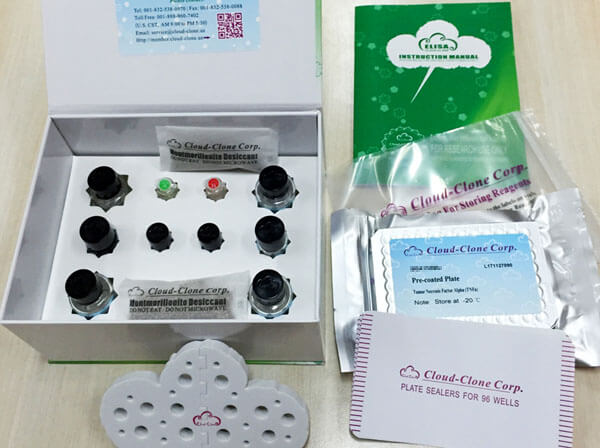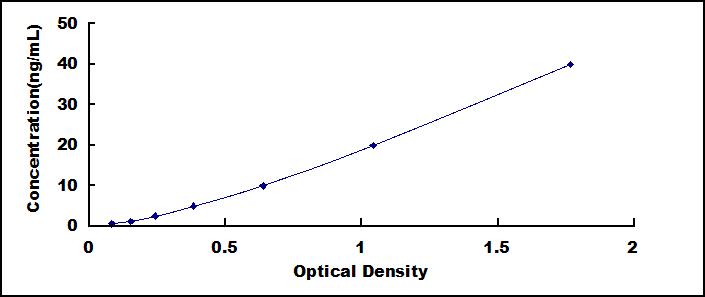ELISA Kit for Amiloride Binding Protein 1 (ABP1) 

AOC1; DAO; KAO; Histaminase; Kidney amine oxidase; Diamine Oxidase; Amiloride-sensitive amine oxidase; Amine oxidase copper domain-containing protein 1
- UOM
- FOB US$ 479.00 US$ 684.00 US$ 3,078.00 US$ 5,814.00 US$ 47,880.00
- Quantity
Overview
Properties
- Product No.SEA656Ra
- Organism SpeciesRattus norvegicus (Rat) Same name, Different species.
- ApplicationsEnzyme-linked immunosorbent assay for Antigen Detection.
Research use only - DownloadInstruction Manual
- CategoryEnzyme & Kinase
Sign into your account
Share a new citation as an author
Upload your experimental result
Review

Contact us
Please fill in the blank.
Recovery
Matrices listed below were spiked with certain level of recombinant Amiloride Binding Protein 1 (ABP1) and the recovery rates were calculated by comparing the measured value to the expected amount of Amiloride Binding Protein 1 (ABP1) in samples.
| Matrix | Recovery range (%) | Average(%) |
| serum(n=5) | 82-89 | 86 |
| EDTA plasma(n=5) | 78-101 | 95 |
| heparin plasma(n=5) | 85-103 | 93 |
Precision
Intra-assay Precision (Precision within an assay): 3 samples with low, middle and high level Amiloride Binding Protein 1 (ABP1) were tested 20 times on one plate, respectively.
Inter-assay Precision (Precision between assays): 3 samples with low, middle and high level Amiloride Binding Protein 1 (ABP1) were tested on 3 different plates, 8 replicates in each plate.
CV(%) = SD/meanX100
Intra-Assay: CV<10%
Inter-Assay: CV<12%
Linearity
The linearity of the kit was assayed by testing samples spiked with appropriate concentration of Amiloride Binding Protein 1 (ABP1) and their serial dilutions. The results were demonstrated by the percentage of calculated concentration to the expected.
| Sample | 1:2 | 1:4 | 1:8 | 1:16 |
| serum(n=5) | 80-90% | 81-99% | 93-101% | 91-105% |
| EDTA plasma(n=5) | 94-102% | 83-94% | 81-97% | 92-101% |
| heparin plasma(n=5) | 93-102% | 95-102% | 87-101% | 86-94% |
Stability
The stability of kit is determined by the loss rate of activity. The loss rate of this kit is less than 5% within the expiration date under appropriate storage condition.
To minimize extra influence on the performance, operation procedures and lab conditions, especially room temperature, air humidity, incubator temperature should be strictly controlled. It is also strongly suggested that the whole assay is performed by the same operator from the beginning to the end.
Reagents and materials provided
| Reagents | Quantity | Reagents | Quantity |
| Pre-coated, ready to use 96-well strip plate | 1 | Plate sealer for 96 wells | 4 |
| Standard | 2 | Standard Diluent | 1×20mL |
| Detection Reagent A | 1×120µL | Assay Diluent A | 1×12mL |
| Detection Reagent B | 1×120µL | Assay Diluent B | 1×12mL |
| TMB Substrate | 1×9mL | Stop Solution | 1×6mL |
| Wash Buffer (30 × concentrate) | 1×20mL | Instruction manual | 1 |
Assay procedure summary
1. Prepare all reagents, samples and standards;
2. Add 100µL standard or sample to each well. Incubate 1 hours at 37°C;
3. Aspirate and add 100µL prepared Detection Reagent A. Incubate 1 hour at 37°C;
4. Aspirate and wash 3 times;
5. Add 100µL prepared Detection Reagent B. Incubate 30 minutes at 37°C;
6. Aspirate and wash 5 times;
7. Add 90µL Substrate Solution. Incubate 10-20 minutes at 37°C;
8. Add 50µL Stop Solution. Read at 450nm immediately.

Test principle
The test principle applied in this kit is Sandwich enzyme immunoassay. The microtiter plate provided in this kit has been pre-coated with an antibody specific to Amiloride Binding Protein 1 (ABP1). Standards or samples are then added to the appropriate microtiter plate wells with a biotin-conjugated antibody specific to Amiloride Binding Protein 1 (ABP1). Next, Avidin conjugated to Horseradish Peroxidase (HRP) is added to each microplate well and incubated. After TMB substrate solution is added, only those wells that contain Amiloride Binding Protein 1 (ABP1), biotin-conjugated antibody and enzyme-conjugated Avidin will exhibit a change in color. The enzyme-substrate reaction is terminated by the addition of sulphuric acid solution and the color change is measured spectrophotometrically at a wavelength of 450nm ± 10nm. The concentration of Amiloride Binding Protein 1 (ABP1) in the samples is then determined by comparing the O.D. of the samples to the standard curve.
Giveaways
Increment services
-
 Single-component Reagents of Assay Kit
Single-component Reagents of Assay Kit
-
 Lysis Buffer Specific for ELISA / CLIA
Lysis Buffer Specific for ELISA / CLIA
-
 Quality Control of Kit
Quality Control of Kit
-
 ELISA Kit Customized Service
ELISA Kit Customized Service
-
 Disease Model Customized Service
Disease Model Customized Service
-
 Serums Customized Service
Serums Customized Service
-
 TGFB1 Activation Reagent
TGFB1 Activation Reagent
-
 Real Time PCR Experimental Service
Real Time PCR Experimental Service
-
 Streptavidin
Streptavidin
-
 Fast blue Protein Stain solution
Fast blue Protein Stain solution
-
 Single-component Reagents of FLIA Kit
Single-component Reagents of FLIA Kit
-
 Streptavidin-Agarose Beads
Streptavidin-Agarose Beads
Citations
- Effects of copper-exchanged montmorillonite, as alternative to antibiotic, on diarrhea, intestinal permeability and proinflammatory cytokine of weanling pigsCas.zju: Source
- A multi-component herbal preparation, STW 5, shows anti-apoptotic effects in radiation induced intestinal mucositis in ratsPubmed:25022208
- Elevation of HO-1 Expression Mitigates Intestinal Ischemia-Reperfusion Injury and Restores Tight Junction Function in a Rat Liver Transplantation ModelPubMed: 26064429
- Early prediction of intestinal mucosal barrier function impairment by elevated serum procalcitonin in rats with severe acute pancreatitis.Pubmed:26804005
- Modulation of gut microbiota contributes to curcumin-mediated attenuation of hepatic steatosis in ratspubmed:28341485
- A DPP-IV-resistant glucagon-like peptide-2 dimer with enhanced activity against radiation-induced intestinal injurypubmed:28522195
- Serum Diamine Oxidase in Pseudoallergy in the Pediatric Populationpubmed:28804811
- Protective effect of aplysin on liver tissue and the gut microbiota in alcohol-fed ratspubmed:28622357
- Protective Effect of Aplysin Supplementation on Intestinal Permeability and Microbiota in Rats Treated with Ethanol and IronPubmed:29861488
- Pregnancy-associated diamine oxidase originates from extravillous trophoblasts and is decreased in early-onset preeclampsiaPubmed:29679053
- Postoperative symbiotic in patients with head and neck cancer: a double-blind randomised trialPubmed:29277158
- The effect of fucoidan on intestinal flora and intestinal barrier function in rats with breast cancerPubmed:29384543
- LOCALIZATION OF COPPER-CONTAINING AMINE OXIDASE ENZYMES IN THE BLOOD
- Effects of fecal microbiota transplantation and joint application of probiotics on rats with alcoholic liver disease
- Potent anti-inflammatory activity of polysaccharides extracted from Blidingia minima and their effect in a mouse model of inflammatory bowel disease
- Modulation of gut microbiota contributes to effects of intensive insulin therapy on intestinal morphological alteration in high-fat-diet-treated micePubmed: 31749050
- Liraglutide Attenuates Nonalcoholic Fatty Liver Disease by Modulating Gut Microbiota in Rats Administered a High-Fat DietPubmed: 32149099
- HMGB1‐associated necroptosis and Kupffer cells M1 polarization underlies remote liver injury induced by intestinal ischemia/reperfusion in ratsPubmed: 31961020
- The effect of Poria cocos ethanol extract on the intestinal barrier function and intestinal microbiota in mice with breast cancerPubmed: 33039631
- Fecal microbiota transplantation from patients with autoimmune encephalitis modulates Th17 response and relevant behaviors in micePubmed: 32821439
- Effects of fucoidan on tumor prevention and gut flora
- Design and development of novel fasudil derivatives as potent anti‐breast cancer agent that improves intestinal flora and intestinal barrier function in rats34587363
- Bovine lactoferricin ameliorates intestinal inflammation and mucosal barrier lesions in colitis through NF-κB/NLRP3 signaling pathways
- Transplanted hair follicle mesenchymal stem cells alleviated small intestinal ischaemia–reperfusion injury via intrinsic and paracrine mechanisms in a rat model








